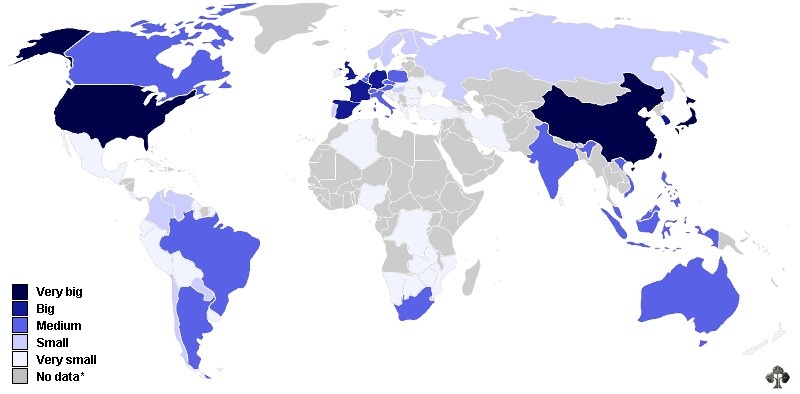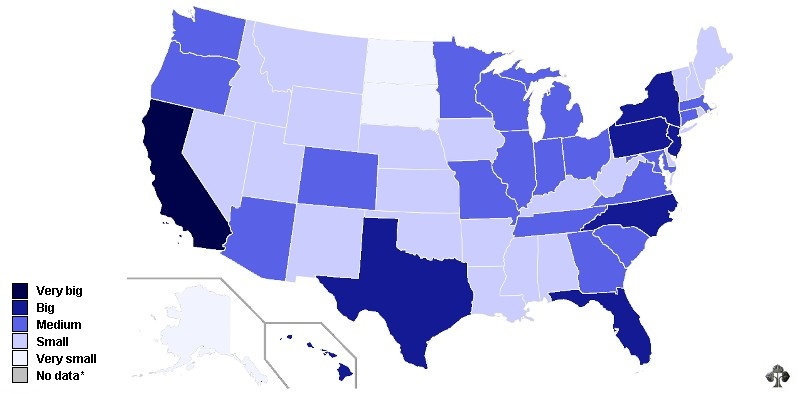How “big” is Bonsai these days? How popular is it in one country/territory compared to another? Where are enthusiasts concentrated? We investigated these questions and present our findings in this article.
The term “bonsai” can refer both specifically to the Japanese form of artistically-trained dwarfed potted trees, and also generally to most similar versions, such as Penjing in China, bunjae in Korea, hon non bo in Vietnam, etc. It is this wider definition of containerized, naturalistically-shaped and usually woody-stemmed perennial plants which we are using in this article.
A brief insight in Bonsai history and the first Western interest
What is now an international horticultural art-form originated close to two millennia ago in what we know as Mainland China. This plant manipulation was then brought over to Japan perhaps a thousand years later where it underwent intensive development along different lines. (Chinese transport of the samples and ideas of artistically-designed dwarfed and potted trees came to other lands in Asia.) Due to the course of Western history, politics, and economics, Europe and North America were strongly introduced to these magical miniature landscapes by way of the Japanese version initially during the latter 19th century. After the damage and discouragement of World War II, interest rebounded in Japan and a renewed sharing with the West occurred. Introduced to it briefly before the war, Australia, South America, and then South Africa embraced Bonsai culture as well. International communication of experiences with these plants has progressed and has only been further spread via the Internet.
So, just how “big” is Bonsai these days? How popular is it in one country/territory compared to another? Where are enthusiasts concentrated? That is the purpose of this article, a graphic and verbal synthesis of a variety of data gathered over the past several years and distilled down over the past several months through a series of e-mails between the editor of this multilingual website, Bonsai Empire, and Bonsai historian/researcher Robert J. Baran. Various reasonings and arguments were put forth for inclusion or not of each location. This past March, the compiled information was first presented on this forum and additionally mentioned on Facebook. We have taken your feedback, made a few changes, and have updated this text to better tell the tale.
How big is Bonsai – country level
The ‘cradle’ of Bonsai lies in China and later Japan, both countries still are (by far) the biggest. In the west, the United States and several countries in Europe (the UK, France, Germany, Spain) are quite big as well. See the map below for a graphical representation of our research.
How big is Bonsai (by country) – Click on the map to enlarge
How big is Bonsai – world-regions level
When combining our country level data into six regions, Asia and Europe are clearly the biggest, followed by Northern America. See the map below for the graphical representation.
How big is Bonsai. by region – Click on the map to enlarge
How big is Bonsai – USA level
As our data included information on the States of America we decided to include these as well. The east coast combined is slightly larger than the west coast, but California is clearly the largest state.
How big is Bonsai in the USA – Click on the map to enlarge
Concluding remarks
Why this article? Because surprisingly few persons around the world seem to have much exposure to “the big picture,” just how mutually shared their interest is in cultures and climates literally a world-apart from their own humble attempts with local plants. Our researches cover Bonsai in the various countries and territories during at least the past fifty years. The specialty magazines and books were our first source of information about this prior to the World Wide Web.
The known presence of even a single enthusiast is the starting point to categorize interest occurring in a location as “Very Small,” if nothing else (source *1). The known presence of clubs and/or public displays (source *2) added to the tally, which can go all the way up to the hosting of national and/or international conventions (source *3), publication of numerous works on the subject (source *4), having a number of national and international teachers and artists (source *5), and being a major trade source for materials (numerous references in advertisements and blogs, for instance). More recent Google searches by country for the term “bonsai” yielded a different, more modern result (source *6). And even the official issuance of postage stamps (source *7) was given a little consideration. The assorted criteria were weighted and the resulting values were placed into the six categories shown.
Similar categorization was then used to define the maps of the World Regions and the individual United Sates of America.
“Big” might also be measured simply in monetary terms: how many dollars, yen, pounds, yuan, euros, rands, etc. the international trade is comprised of for the trees, and their specialty pots, tools, books and magazines, videos, convention/workshop and display admissions, transportation thereof, general nursery material and other products used for Bonsai. volunteered time and donated materials, and even the size of the black market unfortunately connected to this, which includes counterfeit products and illegally-copied or shoplifted and otherwise stolen materials. For now, we are not even attempting to quantify this value.
What is hoped to come from this presentation? More awareness of and dialogue about the wide range of our common interest. Attempts to incorporate elements of other compositions of these into our own works. The presentation of examples of and data for greater local participation in this than has thus far been widely told, including the sharing and translation of local documentation in the media. The further sharing of this horticultural art-form beyond the boundaries of our clubs and enthusiasts, enticing a few more members of the general public into trying their hand at this sometimes challenging and emotionally rewarding form of expression. Greater appreciation of the natural spectrum of plants and landscapes.
We tried to combine as many measurable sources as possible in our research, which gave us a quite clear overview of how big Bonsai is worldwide. We hope that these insights will create more awareness of and dialogue about the wide range of our common interest. Feel free to contact us (using our contact form) to request the data we collected. Written by: Robert J. Baran (most sources can be found on his site) and Oscar.





